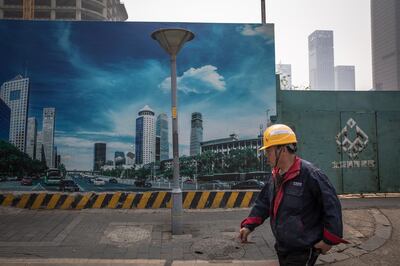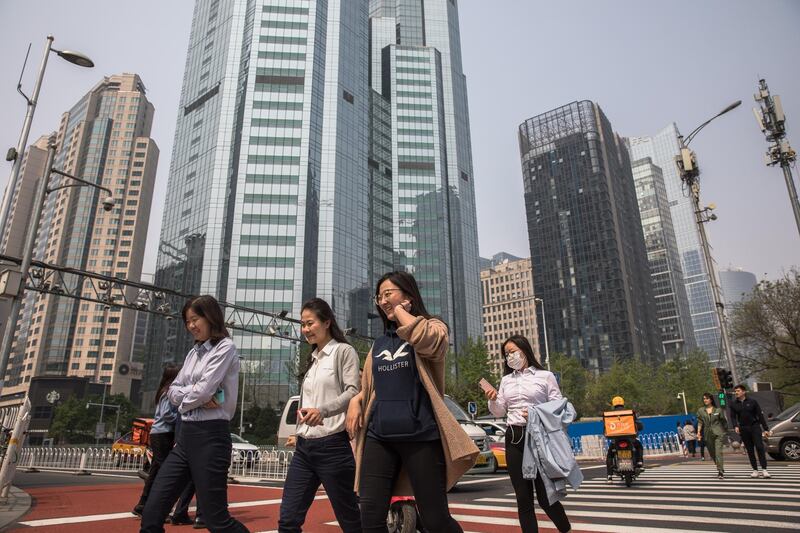China's economy grew at a steady 6.4 per cent pace in the first quarter, defying expectations for a further slowdown, as industrial production jumped sharply and consumer demand showed signs of improvement.
The upbeat readings, which included faster growth in investment, will add to optimism that China's economy may be starting to stabilise even as Beijing and Washington appear to be edging towards a trade deal.
Investors have ranked China's slowdown and the trade war as the biggest risks facing the faltering global economy.
But analysts warn it is too early to call a sustainable turnaround, and further policy support is needed to maintain momentum in the world's second-largest economy. Many had expected a recovery only in the second half of 2019.
Beijing has ramped up fiscal stimulus this year, announcing billions of dollars in additional tax cuts and infrastructure spending, while Chinese banks lent a record 5.8 trillion yuan (Dh3.17tn) in the first quarter, more than the economy of Switzerland.
"We need more evidence to call a full-fledged recovery. Our view for the economy is still cautious," Jianwei Xu, senior economist, Greater China at Natixis in Hong Kong, told Reuters.
"We think it [the stronger-than-expected data] is somewhat linked to the stimulus, but we can't attribute it all to it."
Analysts polled by Reuters had expected GDP growth to slow slightly to 6.3 per cent in January-March from a year earlier.
Share markets and most currencies in Asia rose in relief, as China's slowdown has increasingly weighed on its trading partners from Japan to Germany. The yuan currency rose 0.4 per cent to a 7-week high.
Government support is gradually having an effect, though the economy still faces pressure, Mao Shengyong, spokesman at the National Bureau of Statistics, cautioned on Wednesday.
Quarterly growth was supported by a sharp jump in industrial production, which surged 8.5 per cent in March on-year, the fastest in over four and a half years. That handily beat estimates of 5.9 per cent and 5.3 per cent in the first two months of the year.
Output of building materials such as steel and cement, as well as machinery, showed strong gains. Prices of steel reinforcing bars used in construction hit seven-and-a-half-year highs this week on firm demand.
Industrial output growth will likely remain steady, with exports expected to keep expanding, Mr Mao said.
Exports rebounded more than expected in March, but analysts say the gains could have been due to seasonal factors rather than a rebound in tepid global demand. Long holidays in February likely pushed some production into the following month.
The jump in output was also somewhat at odds with trade data last week, which showed imports shrank for the fourth straight month, suggesting domestic demand is still sluggish.
"We don't think the strength in industrial output is sustainable, said Nie Wen, an economist at Hwabao Trust.
"At home, the huge amount of social financing might ease as the central bank is wary of reigniting property market bubbles, while abroad the global economic recovery is expected to slow down," Nie said, pencilling in more moderate output growth of 6.0-6.5 percent for the rest of the year.
Analysts polled by Reuters expect China's growth to slow to a near 30-year low of 6.2 per cent this year, as sluggish demand at home and abroad and the trade war weigh on activity despite support measures.
The government is aiming for growth of 6 to 6.5 per cent.
Wednesday's data also helped ease fears of weakening consumer confidence in China. Retail sales rose 8.7 per cent in March, beating estimates of 8.4 per cent and the previous 8.2.
Sales were led by stronger demand for appliances, furniture and building materials, reflecting a resurgence in the residential property market, a key economic driver.
Real estate investment rose slightly to 11.8 per cent in the first three months, while construction starts jumped in March. Data on Tuesday showed March new home prices rose at a quicker pace after months of cooling.
But auto sales extended their decline in March, falling 4.4 per cent on-year.
Fixed-asset investment expanded 6.3 per cent in January-to-March on-year, in line with estimates but picking up from the previous period as new road, rail and port projects gathered steam.
Local governments will be allowed to issue 2.15tn yuan of special purpose bonds in 2019 to fund infrastructure projects, a jump of 59 per cent from last year.
On a quarterly basis, GDP in the first quarter grew 1.4 per cent, as expected, but dipped from 1.5 per cent in October-December.

The better than expected Chinese data helped pur oil prices alongsidean industry report signaled an unexpected drop in US crude inventories last week, according to Bloomberg.
Prices advanced as much as 0.9 per cent in New York, while in London Brent futures reached a five-month high. US stockpiles declined by 3.1 million barrels last week, the American Petroleum Institute was said to report. If confirmed by government data due later on Wednesday, that would be the first decline in four weeks and defy analyst forecasts for inventories to rise. China's first-quarter economic growth that beat estimates, added to crude’s upward impetus.
Oil has climbed more than 40 per cent this year as Opec and its allies reduced production and US sanctions on Iran and Venezuela further tightened supply.







